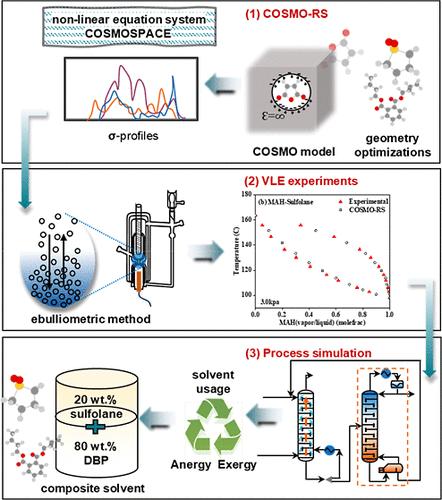马来酸酐生产复合吸收剂的理论发展:COSMO-RS、VLE实验和过程模拟的见解
IF 3.9
3区 工程技术
Q2 ENGINEERING, CHEMICAL
引用次数: 0
摘要
正丁烷氧化法制备马来酸酐,通常由有机溶剂选择性地从富水的反应气流中吸附,但溶剂的疏水性与其对马来酸酐的亲和性之间存在固有的冲突,给该工艺带来了挑战。本文基于cosmos - rs模型、气液平衡实验和工艺模拟,提出了一种复合吸附剂策略,表明在邻苯二甲酸二丁酯中加入20 wt %的亚砜可以有效地平衡疏水性和吸收能力。结果表明,吸收剂消耗、解吸能量需求和火用损失分别降低了40%、27%和38%。微观的σ-曲线和分子表面静电势分布图揭示了吸收能力的增强是由于溶剂和溶质之间互补极性相互作用频率的增加。该方法对萃取剂和吸收剂中溶剂的优化具有更广泛的意义,特别是那些作用于极性溶质体系的溶剂。本文章由计算机程序翻译,如有差异,请以英文原文为准。

Theoretical Development of the Composite Absorbent for Maleic Anhydride Production: Insights from COSMO-RS, VLE Experiments, and Process Simulation
Maleic anhydride, produced via n-butane oxidation, is typically selectively absorbed from the water-rich reaction gas stream by organic solvents, but the process is challenged by the inherent conflict between hydrophobicity of solvents and their affinity for maleic anhydride. Herein, a composite absorbent strategy was proposed based on the COSMO-RS model, vapor–liquid equilibrium experiments, and process simulation, demonstrating that the addition of 20 wt % sulfolane to dibutyl phthalate effectively balances hydrophobicity and absorption capacity. As a result, the absorbent consumption, desorption energy demand, and exergy loss were reduced by 40%, 27%, and 38%, respectively. Microscopic insights from σ-profiles and molecular surface electrostatic potential distribution maps revealed that the enhanced absorption capacity arises from an increased frequency of complementary polar interactions between solvents and solutes. The methodology holds broader implications for optimizing solvents in extractants and absorbents, particularly those acting on polar solute systems.
求助全文
通过发布文献求助,成功后即可免费获取论文全文。
去求助
来源期刊

Industrial & Engineering Chemistry Research
工程技术-工程:化工
CiteScore
7.40
自引率
7.10%
发文量
1467
审稿时长
2.8 months
期刊介绍:
ndustrial & Engineering Chemistry, with variations in title and format, has been published since 1909 by the American Chemical Society. Industrial & Engineering Chemistry Research is a weekly publication that reports industrial and academic research in the broad fields of applied chemistry and chemical engineering with special focus on fundamentals, processes, and products.
 求助内容:
求助内容: 应助结果提醒方式:
应助结果提醒方式:


